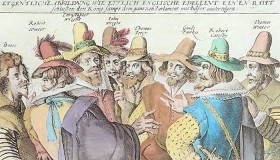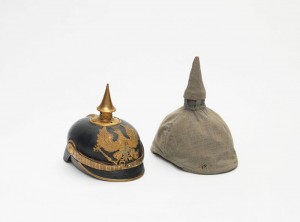The 9th of November was not a day of national commemoration in England, where I grew up. We had to
“Remember, remember the 5th of November, gunpowder, treason and plot…”

The Gunpowder Plot Conspirators, unknown engraver, ca. 1605-1606
This was the date on which Guy Fawkes, a Catholic renegade, dramatically failed to blow up London’s House of Lords. This cultural memory has been faithfully preserved for over 400 years. However, the 9th of November never went unremarked in our household. It was always referred to in German with a shudder: “Kristallnacht,” a name and concept for which no English equivalent exists.
Moving to Germany in 2001, I was surprised to discover that the 9th of November was indeed a day when the organized pogroms against Jews in Germany in 1938 were discussed in the media and commemorative events were held. → continue reading
“Our inclination to hopefulness and expectations of a final victory are unabated and yet the long wait does at times begin to worry us.”
The cultural and literary historian Ludwig Geiger, son of the famous reformist rabbi Abraham Geiger, penned these lines to a friend on 5 December 1914. The “long wait” which had started to trouble him four months after the Great War broke out, ultimately dragged on for almost four more years and yet failed to bring the victory so yearned for. Soldiers at the time could barely imagine what massive destruction this first modern war would wreak. The paltry equipment with which they set off for the front is proof enough of that.

Dr Max Litthauer’s Pickelhaube (spiked helmet) with camouflage covering, 1914–1918. Donated by Bart Ullstein © Jewish Museum Berlin, photo: Jens Ziehe.
On display both in the exhibition “The First World War in Jewish Memory” at the Jewish Museum Berlin and in the special exhibition “1914–1918. The First World War” at the German Historical Museum (DHM) are Pickelhauben, spiked helmets made of hardened (boiled) leather and with a cloth covering for camouflage—for a metal spike protruding above a trench and catching the sunlight made its wearer a sitting target. On my guided tours of the two exhibitions, I take the Pickelhaube as an opportunity to talk about how much this war differed from previous ones as well as how ill-prepared the military was, initially, for the new weaponry deployed.
→ continue reading
With her works for our art vending machines, Deborah Wargon exposes things that got swept under the rug

Portrait of Deborah Wargon © Jewish Museum Berlin, photo: Gelia Eisert
A cordial welcome, the wafting flavors of a freshly-cooked meal, a light-drenched room with a high ceiling, full of brightly-colored books and pictures, and a piano with a sign-post ‘to Australia’ sitting on it… My first encounter with Deborah Wargon in her live-in atelier in Berlin’s Prenzlauer Berg neighborhood is a far cry from the rather severe, somber associations that the term ‘testament enforcer’ brings up for me. Wargon – a musician as well as visual and theater artist born in Melbourne in 1962 – describes herself this way on the package insert that comes with the small-scale artworks that she created for the art vending machine in our permanent exhibition. Those artworks bear the title “The Legacy of Friede Traurig” – where Friede Traurig doubles as a proper name and, in German, to mean peace sorrowful. And Deborah Wargon, who is best known for her paper cuttings inside former insect cases, says that she would rather be sorrowful.
With a little good luck, you may get one of her works from the vending machine: for instance, a little human figurine made of rail track ballast (gravel), wire, and newspaper. Aside from the expressive name Friede Traurig, the materials invoke woeful stories of train transports and barbed wire fences, particularly because the newspapers she used are from the Second World War. But for the artist, it’s clearly not only about the specific time the Nazis were in power and the Shoah. It’s also about the legacies, the inheritance, the stories that we all carry with us. She explains her choice of materials: “For me, wire is a fascinating material. It’s also used for cages. So you can use to suggest the ways that we’re all captive.” The rail track gravel, which normally lies on the ground, relates for Wargon to the ground that we all walk on, as descendants of the people who came before us. “Besides, in both German and English there’s the expression ‘to sweep something under the rug’”. The gravel, or grit, that we bring into the house on the soles of our shoes, and then sweep under the rug, stands for something that we don’t want to face and deal with.
→ continue reading


